

The period from the French revolution to the crisis of 1929, marks the beginning of the industrial area. The fall of the aristocracy benefited bourgeoisie and unbalanced the social and cultural scales: this was the debut of mass-culture and when the building of large concert halls and concert-going became the fashion.
The period of steel and coal celebrated the human network linking values such as work, family and homeland (patriarcal values). Unfortunately in vogue in France in the 40s. Individual slavery was abolished and at the same time colonisation and trading posts were set up in the third world. The instrumental craftmanship became scientific and improvements were made in the standards of resonnance and the projection of sound. The factories were making mass produced instruments and with the introduction of catalogues , their commercial circuits were enlarged even to other countries.
|
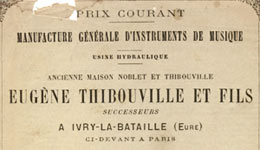 Thibouville, French catalogue. 1887 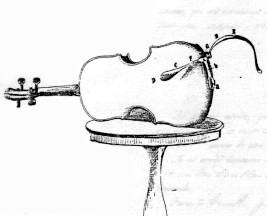 Consili Patent. 1879 | |
Among the numerous patents registered for the instrumental craftmanship, i.e, certain of these patents have played a major role in forcing the players of these instruments to improve and change their technical approach: metallic accessories to stretch fingers,brackets to straighten the head of a young violin player …The medals for these accomplishments had also another side meaning that they set drastic social disciplines depicted in the Victorian period with its gloomy puritanism. What a decline for the human race… | ||
| PEGS The flat peg henceforth in Ebony or Peartree wood dyed black, remains an ordinary model. In France, one often finds Rosewood pegs, much appreciated for their tuning quality. | ||
 |
First appearance of the hollow peg, Hollow cello peg from Laberte |
|
 |
And then the "boudin" peg |
|
TAILPIECE Becoming thicker, to resist a greater tension of strings, but shrinking in width, possibly to economise on wood. It's much more convex, adopting the same bend as the bridge, reinforcing the power of the E and G string. The tailgut string, attached to the button stappled " en cavalier " is progressively abandonned to the benefit of the modern lengthways system. This attachment is in hard metalic string or in gut fiber.   |
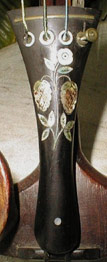 Mother of pearl inlaid | ||
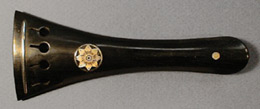 It certainly is a way to reinforce It certainly is a way to reinforcethe power and the attack of the sound. Decorative tailpieces with "mother of pearl" flower motif began around 1870. | |||
| CHINREST The birth of the chinrest: a caricature of 1833 shows this " famous mushroom that sprouts from the edge of violins " : Initially it was very discreet : a simple ebony tongue. It seems obvious that this patch strap harnassed the violin sound, on the other hand, it reduces the wear of the violin top which is made of the tender spruce wood being damaged by the hair of the beard, or by the acidity of perspiration. | |||
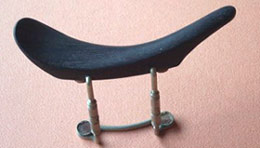 |
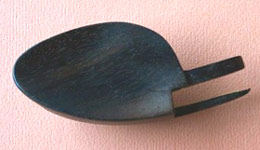 |
||